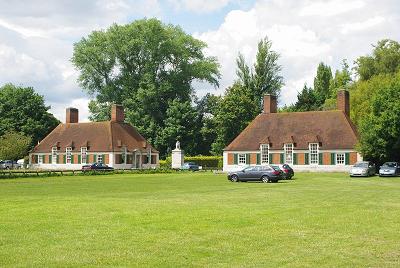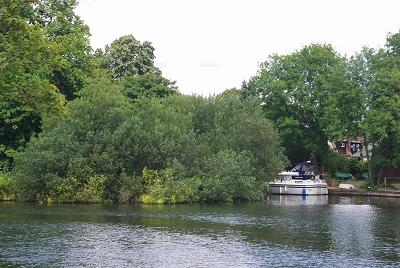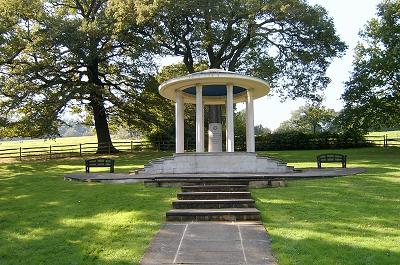Runnymede and Magna Carta
 Lodges at Runnymede
Lodges at Runnymede
A short walk along the road and I pass between two Lodge Houses situated on either side of the carriageway. These lodges were designed by Sir Edwin Lutyens to mark the entrance to Runnymede Meadows. The famous meadows are the site of one of the most significant autograph signings in history. It was here that King John is alleged to have signed Magna Carta, “The Great Charter” in 1215.
Exactly where or how this was done is still the subject of much speculation. When asked where Magna Carta was signed any cheeky schoolboy will reply “At the bottom” which is possibly more accurate than anybody else can place it.
Most people take the story of the signing of Magna Carta a little bit too much on trust. It is when you start to think about it a little more deeply that all sorts of questions spring to mind.
Why Runnymede in the first place? Why in the middle of a field halfway between Windsor and Staines? There was nothing here then, and there is nothing here now except memorials to Magna Carta. However the name “Runnymede” is thought to come from early Anglo-Saxon roots, “runinge” meaning to take council, and “moed” being a meadow. So was this a historic meeting point well before the reign of King John? There is a school of thought that says that King Alfred used to have regular council meetings here known as the “Witan” when he was resident at Old Windsor, just a short distance upriver.
How did it all come about in the first place? The common misconception is that it went something like this…
A group of Barons had decided that they have had their fill of King John demanding this, that and the other from them and giving them nothing back in return. So they banded together and demanded that John meet them on neutral ground. When they were all gathered together one of the barons said “Right John, we will agree to pay some of these taxes if you stop locking us up without trial. We don’t want to pay to go fishing on the Thames neither. Stick your name here and we can all go home”.
You are now thinking, hmmmm, it just might have been a little more complicated than that. Just think of a present-day world summit meeting with their thousands of negotiators and back-room support staff. They have computers and all sorts of whizz-kiddery and it takes months of preparation and days of talks to get anywhere. How did they do it all in 1215 in one afternoon when the height of technology was the quill pen?
It will be no great surprise to learn that the school version of Magna Carta is a massive over-simplification.
Firstly, King John did not sign Magna Carta at Runnymede. He placed his seal at the bottom of a draft form of the document called “Articles of the Barons”, and as this was properly witnessed under Common Law it became legally binding. The document was not signed (or sealed) by any of the barons. The full Magna Carta, (translation Great Paper) was not sealed until a month later after the Chancery had redrafted it into the final document.
Let’s take a more detailed look at the background.
 Magna Carta Island
Magna Carta Island
By the end of the 12th century the Norman system of government had enabled the King of England to become the most powerful man in Western Europe. Power has a nasty habit of going to ones head and King John was no exception. I have already discovered during the course of my journey that John was not one of our better rulers, and he soon started to get things very, very wrong.
John was not the only choice for King when his older brother Richard died. There was also considerable support for Richard’s nephew, Arthur of Brittany. To secure the throne of England John needed the support of the King of France, Philip Augustus. In order to help Philip decide to support his claim to the crown, John gave the King of France a large portion of the lands he held in Anjou. Big mistake.
In every really big mess, there always has to be a woman involved somewhere. The woman in this case was Isabella of Angouleme who John had taken rather a shine to and decided to marry. Isabella’s jilted fiancée, Hugh IX of Lusignan, did not take this too well, and appealed to Philip to help him get his revenge on John. Philip immediately declared all the remainder of John’s French lands to be forfeit, invaded them with his army and gave them to Arthur of Brittany to rule over.
John had to act to save face, and despatched his armies across to France to grab his lands back. His French barons were not exactly supportive, for Arthur of Brittany had suddenly died in mysterious circumstances. You can guess who (probably correctly) was getting all the blame. John’s allies (what was left of them) were defeated at the Battle of Bouvines and the lands were finally conceded to France. The revenue from these lands had previously generated a significant part of the crown income, and put a severe hole in the budget. John decided to squeeze the Barons for more taxes to make up the shortfall, so tightening the pressures that would lead to the revolt.
There was no constitutional crisis in the medieval days that the involvement of the Church could not make considerably worse. It’s about time we looked at their contribution to this hiatus. The appointment of the Archbishop of Canterbury had always been a contentious issue, but took a new turn following the crowning of King John.
Until 1200 the Archbishop had been selected by the monarchy in consultation with the monks of Canterbury. Now the monks wanted more say, and elected one of their number to be the new Archbishop. John responded by sending John de Gray, Bishop of Norwich to Rome as his appointed Archbishop. The Pope, Innocent III, decided that he would have neither of them and persuaded the monks to elect Stephen Langton instead. Upon hearing this John completely threw his teddy out of the pram and ordered all of the Canterbury monks into exile. The Pope hit back, and ordered an interdict, whereby all acts of worship, mass, marriages and even the ringing of church bells were declared illegal in England from 1208. When John did not respond, Innocent upped the ante by excommunicating the King in 1209. After receiving no response from this action, the Pope started to encourage Philip of France to invade and conquer England. John eventually backed down, and agreed to have Bishop Langton as Archbishop and allowed the monks to return. To further placate the Pope, he also gave England and Ireland to become Papal Territories and rent them back. The Barons were not happy about this at all, seeing it as selling out to the Papal powers.
So now we have land, power, women and religion all in the melting pot. All we need to do now is add a few money problems and the whole lot will go bang. Which is exactly what happened?
The state income was devastated and tax revenues were required to finance the wars necessary to win back the lost lands. John used all the trickery and double-talk he could to raise the levels of taxation. He re-interpreted Forest Law, which applied to hunting rights in the Royal Forests. He increased by several fold the taxes in scutage, which was the payment of taxes instead of providing military service, and worst of all he introduced a form of income tax, that was as popular then as its descendant is today.
The Barons had suffered enough, and together they marched on London. Such was the unpopularity of John that the city threw its gates open in welcome to them. The combined forces of the Barons were enough for John to meet them at Runnymede and put his seal to “The Articles of the Barons” on June 15th 1215. Magna Carta. On June 19th the Barons responded by re-affirming their fealty to King John.
The Chancery then took the various clauses and made them into Magna Carta. Several copies were made and distributed to the Barons, Royal Sherrifs and Bishops.
The major cause of concern to John was clause number 61. This clause was the longest part of the document, and the part that everyone knows something about. It established a committee of 25 barons who could meet at any time and over-rule the King, even to the extent of confiscating his property.
All the way through the process John had been unable to take any situation without making it a whole lot worse, and as soon as the barons had left London he was at it again. He renounced the clause, and England was plunged into yet another civil war, the First Barons’ War.
John died in 1216 and his son Henry III succeeded to the throne. This is where William Marshall, who we discovered at Caversham a few days ago, comes into play. He, as we have learned, was Henry’s Regent, and he set about revising Magna Carta to keep the peace. On November 12th 1216 the revised Magna Carta, without clause 61 was issued, followed by a further revisions in 1217 and 1225, by which time it had been reduced to 37 clauses.
The version of Magna Carta so often quoted in English Law is the final version, which was issued by Edward I on October 12th 1297, just over eighty years after the original version. Every King for the next two hundred years included the charter of 1297 in their charters until Henry V put an end to the practice.
At the present day only three of the clauses of 1297 remain in their original form, clauses 1, 19 and 28. Clause 1 guarantees the freedom of the Church of England, Clause 9 covers the ancient liberties of the City of London and Clause 29 guarantees a right to due process by the law.
- I. FIRST, We have granted to God, and by this our present Charter have confirmed, for Us and our Heirs for ever, that the Church of England shall be free, and shall have all her whole Rights and Liberties inviolable. We have granted also, and given to all the Freemen of our Realm, for Us and our Heirs for ever, these Liberties under-written, to have and to hold to them and their Heirs, of Us and our Heirs for ever.
- IX. THE City of London shall have all the old Liberties and Customs which it hath been used to have. Moreover We will and grant, that all other Cities, Boroughs, Towns, and the Barons of the Five Ports, and all other Ports, shall have all their Liberties and free Customs.
- XXIX. NO Freeman shall be taken or imprisoned, or be disseised of his Freehold, or Liberties, or free Customs, or be outlawed, or exiled, or any other wise destroyed; nor will We not pass upon him, nor condemn him, but by lawful judgment of his Peers, or by the Law of the Land. We will sell to no man; we will not deny or defer to any man either Justice or Right.
Where on these meadows it was signed is anybody’s guess. There is a school of thought that says it was not at Runnymede at all, but on Magna Carta Island which is reached from the opposite bank. It would certainly have been a more strategic place for meeting a slippery rascal like King John. Being an island would have made it difficult for John to spring any nasty tricks and surprises such his troops suddenly appearing midway through the proceedings before the barons had a chance to defend themselves. During the time of Magna Carta the island was used by the nunnery of Ankerwyke and it could be that this was the place where John and the Barons met because both sides felt relatively safe on the confined island.
So that was Magna Carta, and a fine memorial exists in the National Trust grounds to commemorate it. The Runnymede Memorials are a short walk from the car park. It is with some surprise that I discover that the Magna Carta Memorial is not anywhere near as old as I had assumed it would be.
 Magna Carta Memorial
Magna Carta Memorial
There are three memorials overlooking the Thames at Runnymede. The oldest is towards the top of the hill. It is administered by the Commonwealth War Graves Commission and is dedicated to the memory of the men and women of the Allied Air Forces who died during the Second World War. This fine memorial was designed by Sir Edward Maufe and unveiled by the Queen on 17th October 1953. Over the entrance there is a dedication; “In this cloister are recorded the names of 20,456 airmen who have no known grave. They died for freedom in raid and sortie over the British Isles and the land and seas of northern and western Europe.”
The Magna Carta Memorial was built by the American Bar Association from donations from over 9,000 American lawyers. This memorial is in the shape of a domed classical temple containing a pillar which carries the inscription; “To commemorate Magna Carta, symbol of Freedom Under Law”. Sir Edward Maufe also designed this memorial. It was unveiled on 18th July 1957, a mere 742 years after the event it commemorates. There are visitor information plaques displaying the coats of arms of the twenty-five Barons and Bishop Langton accompanied by a brief description of Magna Carta for the benefit of visitors.
The third memorial stands on one acre of ground that is now the property of the United States of America. This memorial was designed by G.A.Jellicoe and unveiled by the Queen on 14th May 1965. It is dedicated to the memory of John F Kennedy who was assassinated on 22nd November 1963. The inscription reads “This acre of ground was given to the United States of America by the people of Britain in memory of John F Kennedy, born 19th May 1917: President of the United States 1961-63: died by an assassin’s hand 22nd November 1963. “Let every National know, whether it wishes us well or ill, that we shall pay any price, bear any burden, meet any hardship, support any friend or oppose any foe, in order to assure the survival and success of liberty”: from the inaugural address of President Kennedy, January 1961.”
< Previous Page | Next Page >